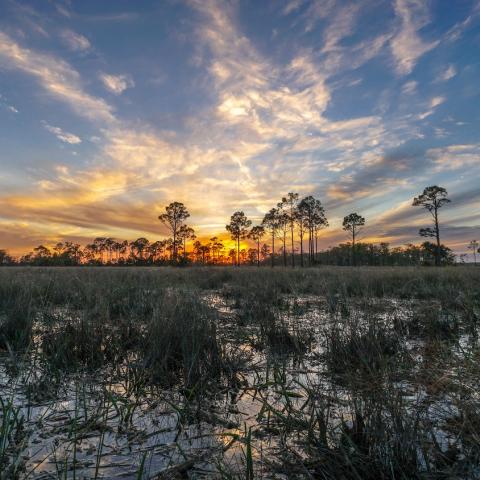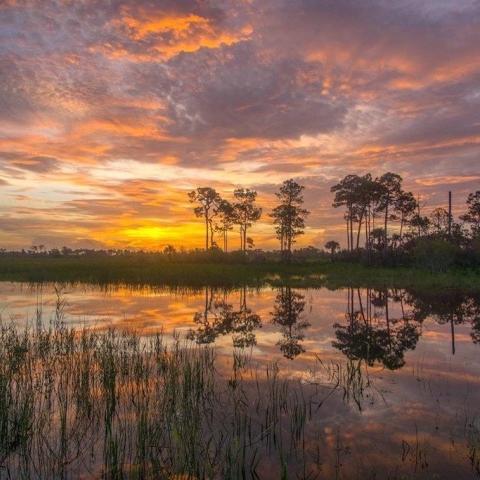
Interior Department officials have released a draft strategic plan for combatting invasive species, such as Burmese pythons, on federal lands/NPS file
Interior Department officials have released a draft plan for battling invasive species such as Burmese pythons and Asian carp that threaten to upset native species in national parks and other public lands.
As Traveler noted in December, there has been, for a disturbing amount of time, a slow, creeping invasion of the national parks, one arriving in the form of an ecosystem-upsetting menagerie that poses a significant threat to both native species and the very integrity of the parks.
It is an invasion on land and in the water, one that is attacking wildlife that has evolved with the landscapes. For some parks, the problem has gone beyond being an isolated problem and turned into a malevolent force that is literally impairing the very nature of the parks and some of the reasons they were set aside in the first place.
This past week Interior released its draft strategic plan for combating an estimated $120 billion problem—invasive species. Administrations have worked over the decades to manage invasive species, which impact water supplies, impair hunting and fishing opportunities, interfere with energy production, exacerbate wildfires, damage America’s agriculture and drive native species to extinction.
The Trump administration's plan was called for by Congress through the John D. Dingell, Jr. Conservation, Management and Recreation Act, which directed Interior and other relevant agencies to "develop a strategic plan for the implementation of the invasive species program to achieve, to the maximum extent practicable, a substantive annual net reduction of invasive species populations or infested acreage on land or water..."
The plan emphasizes interagency coordination, cost-effective control, science based practices and decision-making. It also allows for regional flexibility, asking the department to work with governors and other stakeholders. According to a release announcing the 60-day public comment period on the plan, it provides "a coordinated approach to further align programs and policies across the U.S. Department of the Interior and leverage more resources in addressing this important issue. In Fiscal Year 2020, Interior alone is investing an estimated $143 million to manage invasive species."
“The Trump administration has been focused on addressing the considerable, negative impacts of invasive species by working across jurisdictional boundaries with our partners,” said Interior’s acting assistant secretary for policy, management and budget, Scott Cameron. “The draft plan sets out a vision for effectively managing invasive species through collaborative conservation to protect our nation’s biodiversity and economy.”
Successfully tackling the problem is critical for national parks such as Everglades and Big Cypress National Preserve in Florida.
“In South Florida, the spread of invasive plant and animal species has long had negative impacts upon the native flora and fauna across the Greater Everglades ecosystem. In Everglades National Park, a decades-long collaborative effort has been underway to eradicate Brazilian pepper plants, Schinus terebinthifolius, from thousands of acres through what is called the 'Hole in the Donut' restoration project," said Dr. Melissa Abdo, the Sun Coast regional director for the National Parks Conservation Association. "Just this summer, we are also witnessing possible expansion of ranges of other invasive species in South Florida, such as shoebutton ardisia, Ardisia elliptica, which is now being spotted in areas of Big Cypress National Preserve where it wasn’t previously invading.
"The Department of the Interior has estimated that not even 1 percent of invasive plant populations are considered 'under control' on DOI lands, and the number for invasive animal populations is not much better – around 10 percent are likely under control," she added. "As climate change is now adding complexity to the massive challenge of preventing, detecting, and eradicating invasive species, we are keen to see science-based efforts ramped up in order to tamp down the threat that invasive species pose to our natural heritage.”
According to an Interior news release, this strategic plan outlines a comprehensive, agency-wide approach that will:
- Promote partnerships to bolster mutual priorities,
- Raise awareness to motivate action,
- Strengthen prevention practices to avoid invasive species introductions and spread,
- Improve the coordination of early detection and rapid response efforts across jurisdictions,
- Leverage opportunities for targeted control and eradication and
- Improve data collection and data management to facilitate more effective decision-making.
The release stated that the plan "represents an aggressive push to continue the progress that has been made, using a science-based approach and working closely with federal, state, local and tribal partners around the nation to prevent, contain and control invasive species that damage our landscapes."
Great Lakes Region
In the Great Lakes, where Asian carp put at risk the region’s $7 billion fishing industry, Interior says the administration invested more than $35 million in 2020 alone toward work by the U.S. Geological Survey, Fish and Wildlife Service, and National Park Service to combat the spread of invasive carps, including along the Mississippi River. In collaboration with partners, Interior has conducted control activities on 153,000 acres and removed more than 8.5 million pounds of Asian carp from the Illinois River.
Florida Everglades
In the Florida Everglades, where Burmese pythons consume native wildlife and disrupt the ecosystem, a portion of the more than $20 billion the administration has committed to restore the South Florida ecosystem will be used to combat pythons’ spread, according to Interior. Using new technologies such a radio telemetry, Interior for the first time is tracking pythons in many different habitats to better understand their biology and ultimately find ways to more effectively control this invasive species.
Western United States
To protect the Western United States from quagga and zebra mussels that annually cause more than $1 billion in economic impact and management costs, Interior launched numerous initiatives in 2017 in collaboration with Western governors and federal, state and tribal agencies. Under this administration, Interior has invested approximately $41 million since Fiscal Year 2017 to identify and implement actions such as boat inspections with states, and early detection of and rapid response to mussel invasions, the release said.
Guam
Interior has been supporting efforts to eradicate brown tree snakes in Guam, where they cause $4.5 million annually in damage to electric power, tourism, recreation and national security infrastructure. Over the past four years, the Office of Insular Affairs has provided more than $12 million for the Brown Tree Snake Control program to help islanders prevent the dispersal of the snakes from Guam to other vulnerable geographic areas in the Micronesia region including Hawaii and to ultimately eradicate existing or newly established snake populations in U.S. areas.




 Support Essential Coverage of Essential Places
Support Essential Coverage of Essential Places







Add comment